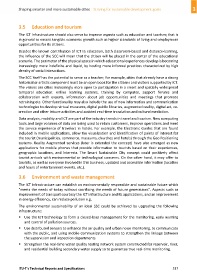Page 327 - Shaping smarter and more sustainable cities - Striving for sustainable development goals
P. 327
3.5 Education and tourism
The ICT infrastructure should also serve to improve aspects such as education and tourism; that is
in general to ensure tangible economic growth such as higher standards of living and employment
opportunities for its citizens.
Besides the known contribution of ICT to education, both classroom‐based and distance‐learning,
the influence of the SCC will mean that the citizen will be placed in the center of the educational
scenario. The perimeter of the physical space in which educational experiences develop is becoming
increasingly more indefinite and liquid, by hosting more informal practices characterized by high
density of social interactions.
The SCC itself has the potential to serve as a teacher; for example, cities that already have a strong
historical or artistic component must be an open book for the citizens and visitors supported by ICT.
The visions are cities increasingly more open to participation in a smart and spatially widespread
temporal education: online learning systems, training by computer, support forums and
collaboration with experts, information about job opportunities and meetings that promote
retraining etc. Other functionality may also include the use of new information and communication
technologies to develop virtual museums, digital public libraries, augmented reality, digital art, co‐
creation and other leisure activities and assisted real‐time translation and cultural mediation.
Data analysis, mobility and ICT are part of the industry trends in travel and tourism. New computing
tools and large volumes of data are being used to retain customers, improve operations and meet
the service experience of travelers in hotels. For example, the Electronic Guides that are found
included in mobile applications, allow the visualization and identification of points of interest for
the tourist (municipalities, commerce, museums, churches and hotels) through the Geo Positioning
systems. Reality Augmented services (later is extended the concept) have also emerged as new
applications for mobile phones that provide information to tourists based on their experiences,
geographic locations, and interests. The Smart Sustainable City concept could positively affect
tourist arrivals with environmental or technological concerns. On the other hand, it may offer to
tourists, as well as everyone involved in this business, updated and accessible information (location
and hours of entertainment events, etc.).
3.6 Environment and waste management
The ICT infrastructure can establish an environmentally responsible and sustainable future which
"meets the needs of today without sacrificing the needs of future generations". Aspects such as
improvement of transport courtesy the ICT infrastructure and its applications, and an improvement
in energy efficiency, can reduce pollution e.g.
The environmental sustainability of an ideal SSC could be achieved by upgrading the following
infrastructure:
Use the IoT technology to form a closed‐loop management for the monitoring, early warning
and control of pollution sources.
Use distributed sensors to enhance the air quality and urban noise monitoring, to communicate
with the public, and using mobile communication systems to strengthen the linkage between
the supervision and inspection departments.
Strengthen the real‐time water quality testing network system constructed for reservoir, river,
and residential building secondary water supply so to guarantee true real‐time monitoring.
ITU‐T's Technical Reports and Specifications 317

